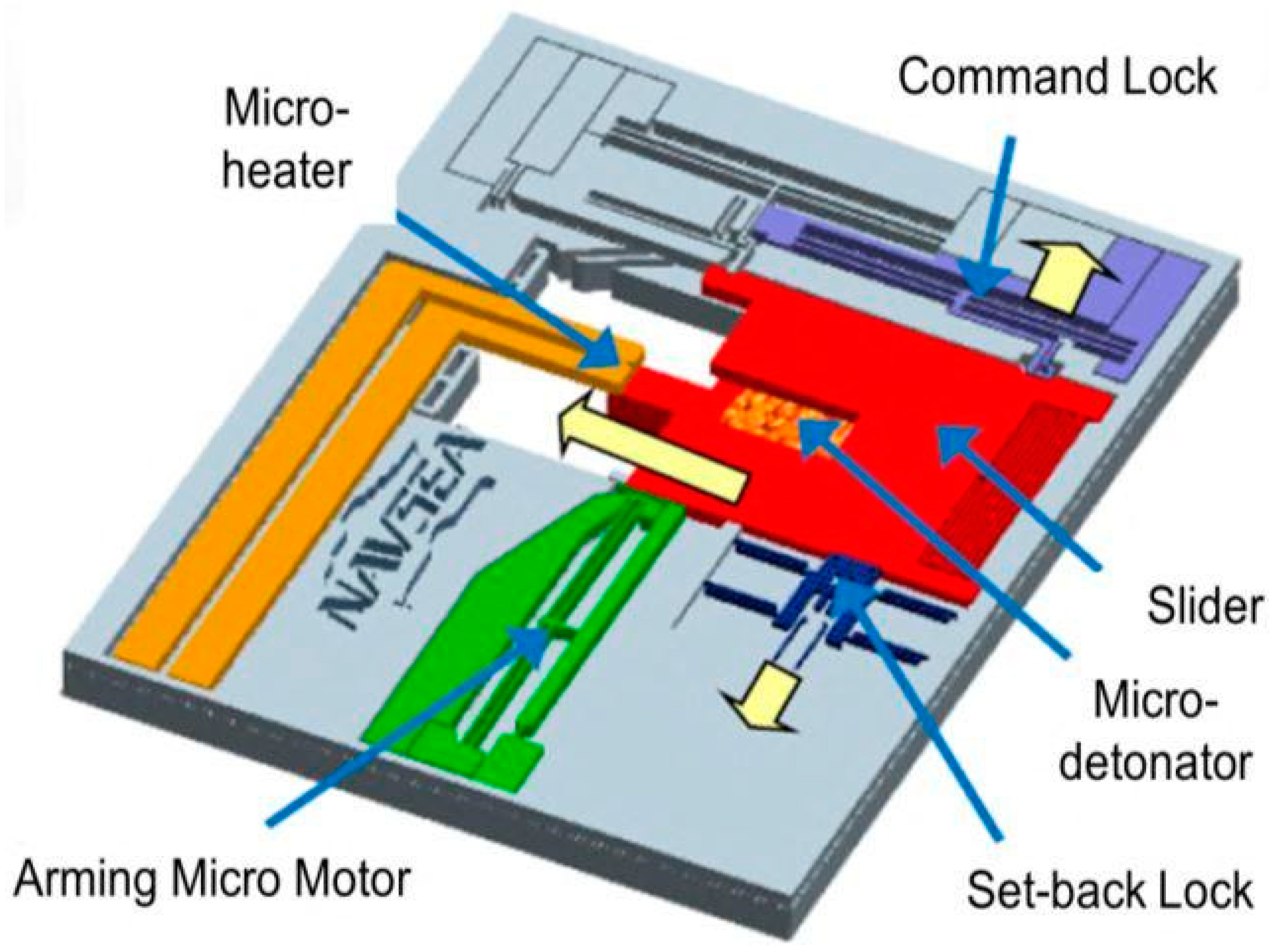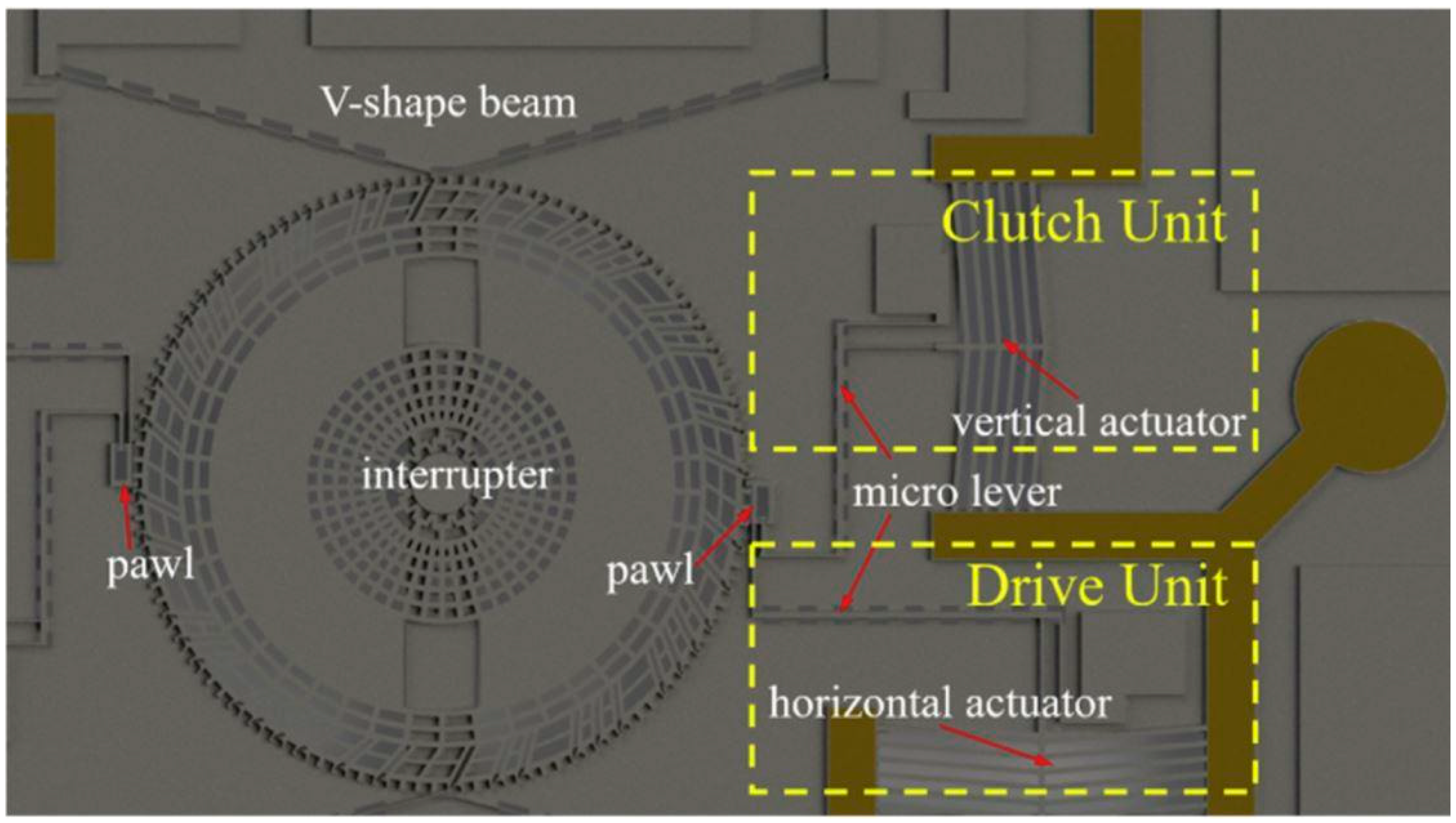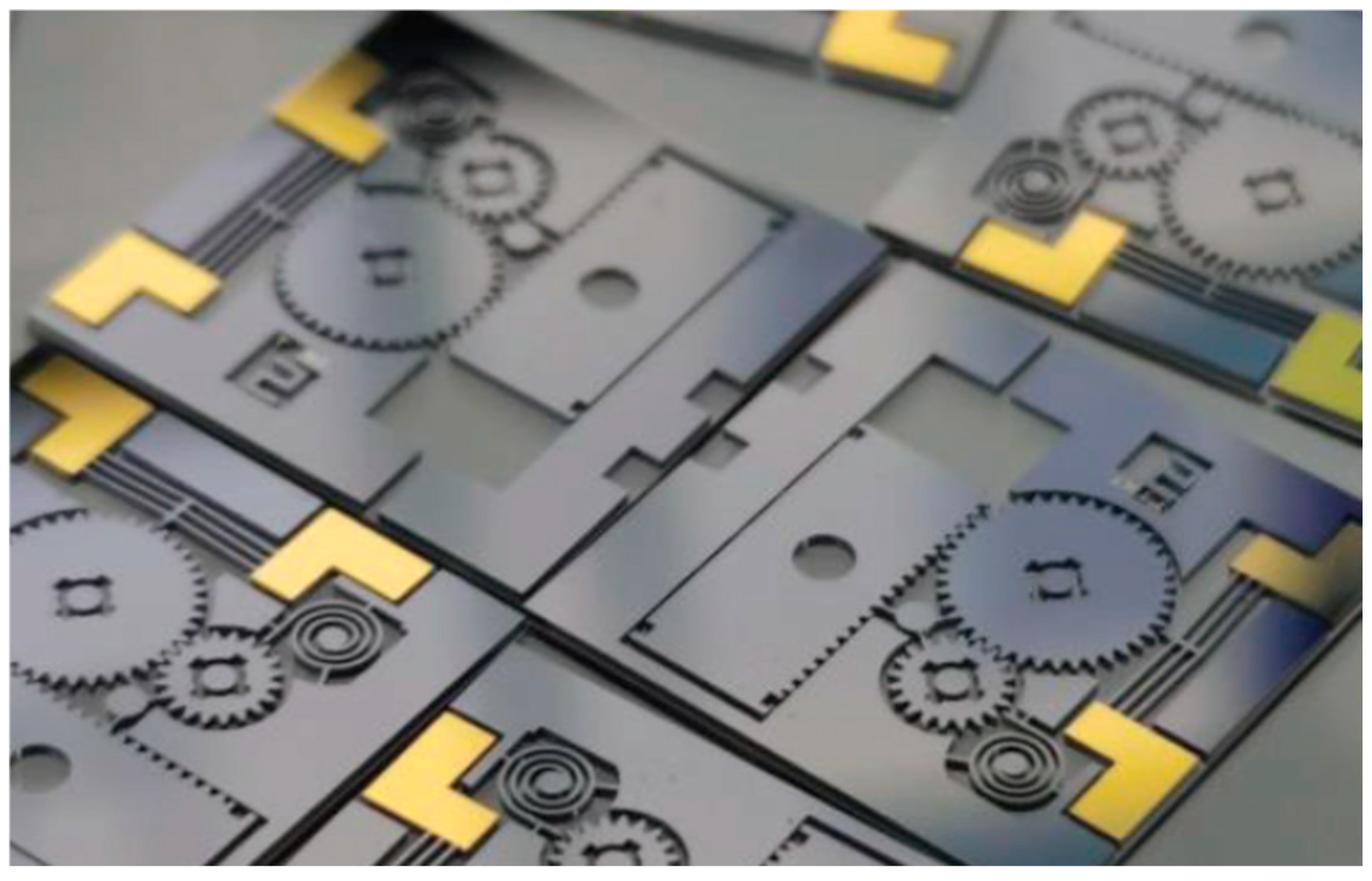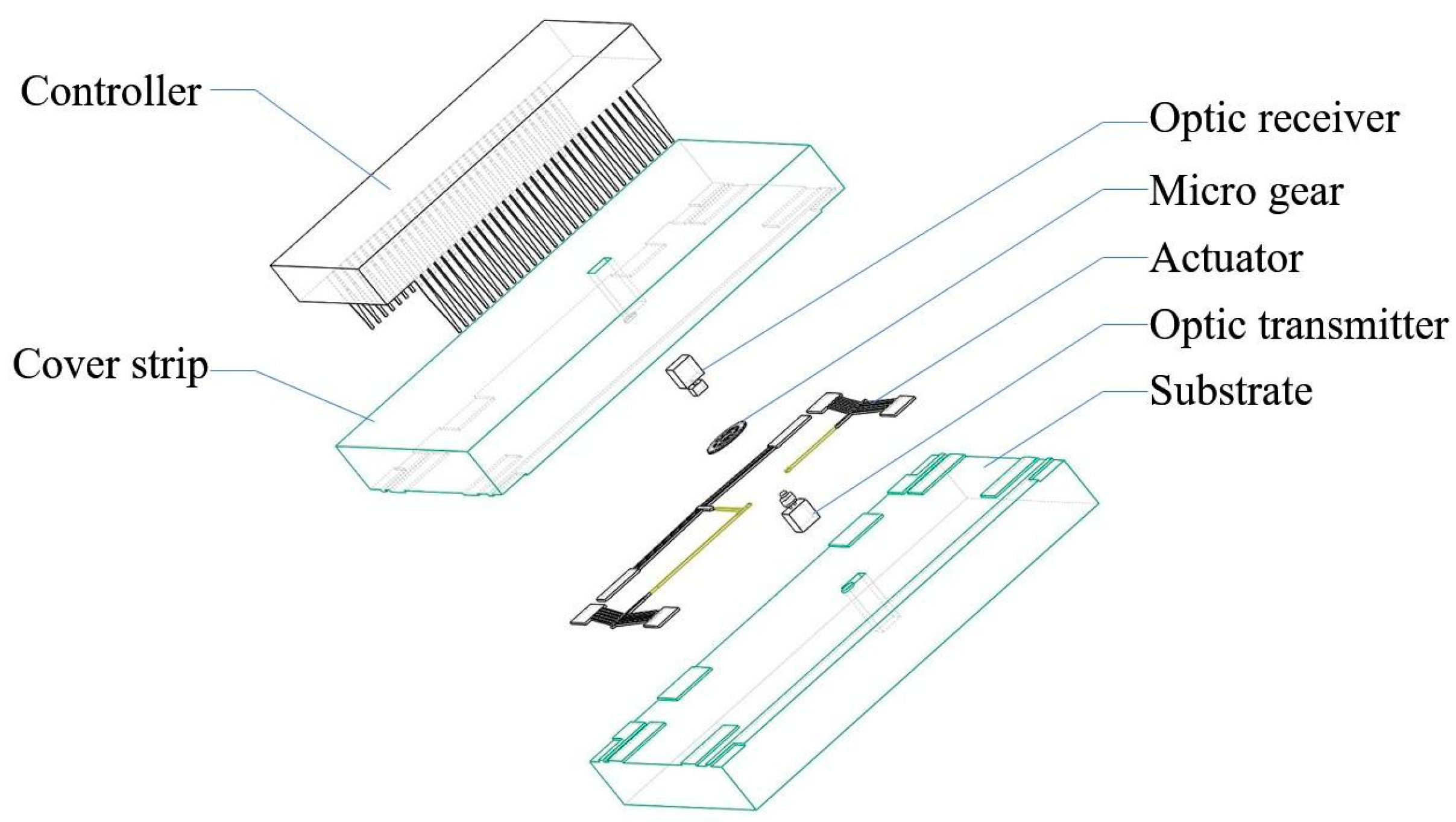Application Prospects of a Silicon-Based MEMS Safety and Arming Device for a Micro-Explosive Train
Abstract
1. Introduction
2. Research Status of MEMS S&A Devices
2.1. Classification of Micro-Explosive Trains
2.2. Displaced Explosive Train Structure MEMS S&A Device
2.3. Isolated Explosive Train Structure MEMS S&A Device
2.4. Analysis of the Current Situation of MEMS S&A Devices
3. Prospects
3.1. Miniaturization and Integration
3.1.1. Composite Materials for MEMS S&A Device Manufacturing
3.1.2. Precision of the MEMS S&A Device Structure
3.1.3. Diversified Driving Methods for MEMS S&A Devices
3.1.4. MEMS S&A Device Partition Self-Recovery Function
3.2. Informationization
3.2.1. Precision of Information Perception and Control
- Temperature monitoring: Pyrotechnics are highly sensitive to temperature changes, and excessively high temperatures may cause pyrotechnic failure or danger. Micro-nano-sensors can monitor the temperature of pyrotechnic devices in real time. Once an abnormal temperature is detected, an alarm is immediately triggered to remind relevant personnel to take appropriate measures.
- Pressure perception: Pyrotechnics may be subjected to compression or impact during transportation and storage, resulting in changes in internal pressure. Micro-nano-sensors can accurately sense these pressure changes, ensuring the safety of pyrotechnic devices during transportation and storage.
- Vibration detection: Vibration is also one of the important factors affecting the safety of pyrotechnic devices. Micro-nano-sensors can monitor the vibration of pyrotechnic devices in real time, analyze the source and intensity of vibration, and provide important reference information for safety mechanisms.
3.2.2. Intelligent Information Judgment and Control Strategy
3.2.3. Diversify Control Signals
3.2.4. MEMS S&A Device Self-Energy Storage
4. Conclusions
Author Contributions
Funding
Conflicts of Interest
References
- Wang, K.M.; Wen, Y.Q. Design of Initiators and Pyrotechnics for Weapon Systems; National Defense Industry Press: Beijing, China, 2006. [Google Scholar]
- Chu, E.Y.; Zhang, F.; Chen, J.H.; Wang, Y.L.; Xue, Y.; Xie, R.Z. Supplementary discussion of concepts of the 4th generation pyrotechnics. Initiat. Pyrotech. 2020, 6, 1–4. [Google Scholar]
- Chu, E.Y.; Zhang, F.; Zhang, R.; Xue, Y.; Ren, W.; Wang, Y.L.; Xie, R.Z. Preliminary discussion of new concepts of the 4th generation pyrotechnics. Initiat. Pyrotech. 2018, 1, 1–5. [Google Scholar]
- Cui, Z.Z. Some Issues on the Fuze Development. J. Detect. Control 2008, 30, 1–4. [Google Scholar]
- Li, H.J.; Zhang, H. Discussion on Fuze Safety System and Its Function Category. J. Detect. Control 2006, 28, 4–7. [Google Scholar]
- Zhang, H. Research on Basic Issues of MEMS Security Systems. Master’s Thesis, Nanjing University of Science and Technology, Nanjing, China, 2008. [Google Scholar]
- Liu, W.; Chu, E.Y.; Liu, L.; Ren, X.M.; Xie, R.Z.; Ren, W.; Li, J. Research progress on micro detonation sequence technology based on the principle of flyer impact detonation. Chin. J. Energetic Mater. 2023, 31, 606–634. [Google Scholar]
- Xu, N.; Nie, W.R.; Xi, Z.W.; Zheng, C.; Li, W.D. MEMS centrifugal flameproof slider locking mechanism. J. Detect. Control 2019, 4, 15–19. [Google Scholar]
- Li, G.Z. Research on Micro Safe and Arming System. Ph.D. Thesis, Beijing Institute of Technology, Beijing, China, 2016. [Google Scholar]
- Feng, P.Z.; Zhu, J.N.; Wu, Z.L. Analysis of US Typical MEMS Fuze Safety & Arming Device. J. Detect. Control 2007, 29, 26–30+33. [Google Scholar]
- Wang, K.M.; Cai, R.J.; Yan, N.; Jiao, Q.J. Analysis on the Research and Development of the Explosive Trains in Foreign Countries. Initiat. Pyrotech. 2001, 1, 42–46. [Google Scholar]
- Li, M.; Hu, T. Research status and development trend of MEMS S&A devices: A review. Defin. Technol. 2021, 17, 450–456. [Google Scholar]
- Pezous, H.; Rossi, C.; Sanchez, M.; Mathieu, F.; Dollat, X.; Charlot, S.; Conédéra, V. Fabrication, assembly and tests of a MEMS-based safe, arm and fire device. J. Phys. Chem. Solids 2010, 71, 75–79. [Google Scholar] [CrossRef]
- Pezous, H.; Rossi, C.; Sanchez, M.; Mathieu, F.; Dollat, X.; Charlot, S.; Salvagnac, L.; Conédéra, V. Integration of a MEMS based safe arm and fire device. Sens. Actuators A Phys. 2010, 159, 157–167. [Google Scholar] [CrossRef]
- Young, T.T. DoD MEMS fuse reliability evaluation. In Proceedings of the 59th Annual NDIA Fuze Conference, Charleston, SC, USA, 3–5 May 2016; Volume 5. [Google Scholar]
- Zhou, X.; Shan, T.; Qi, X.; Cui, L. Analysis and design of a high power laser interrupter for MEMS based safety and arming systems. Microsyst. Technol. 2017, 23, 3175–3184. [Google Scholar] [CrossRef]
- Hu, T.J.; Ren, W.; Zhao, Y.; Xue, Y. The research on actuation performance of MEMS safety and arming device with interlock mechanism. Micromachines 2019, 10, 76. [Google Scholar] [CrossRef]
- Fang, K.; Hu, T.J.; Jiang, X.H.; Zhao, Y. Research on a MEMS based encrypted rotary safety and arming device. Sens. SA Device A Phys. 2020, 301, 111781. [Google Scholar] [CrossRef]
- Kan, W.; Chu, E.; Liu, W.; Ren, W.; Ren, X. A Review on MEMS Safety and Arming Devices for Micro-initiation System. Chin. J. Energetic Mater. 2022, 30, 78–94. [Google Scholar]
- Zhang, H.; Dai, K.R. Development and prospect of advanced fuze technology. Chin. Sci. Bull. 2023, 68, 3293–3310. [Google Scholar] [CrossRef]
- Wang, K.; Hu, T.; Zhao, Y.; Ren, W.; Liu, J. Design of a double-layer electrothermal MEMS safety and arming device with a bistable mechanism. Micromachines 2022, 13, 1076. [Google Scholar] [CrossRef]
- Zhang, Y.; Jiang, Q.; Liu, W.; Ren, X.; Liu, L. Design and Performance of Micro Safety and Arming Device Based on Laser Processing. Chin. J. Energetic Mater. (Hanneng Cailiao) 2024, 32, 83–91. [Google Scholar]
- Li, H.; Luo, J.J.; Xu, X.; Feng, C.Y.; Liu, T.; Gao, Y.Y. Dual-environment-driven MEMS pyrotechnic actuators. J. Phys. Conf. Ser. 2023, 2478, 102017. [Google Scholar] [CrossRef]
- Zhu, Y.L.; Chen, H.S.; Zhao, W.J.; Quan, T.; Zeng, X.; Chang, Y.K.; Jiao, Q.J. Preliminary Discussion of the Concept of Information-based Pyrotechnics. Initiat. Pyrotech. 2023, 6, 49–55. [Google Scholar] [CrossRef]
- Zheng, B.W.; Mao, B.Q.; Zhong, M.C.; Yang, Y.Y. Development Status and Key Technology Analysis of Intelligent Weapon Station. Fire Control Command. Control 2020, 45, 1–7. [Google Scholar]
- Yin, G.F.; Zhang, J.C.; Ren, X.; Han, K.; Li, N. Design and Feasibility of an Addressable Initiation Network System. Chin. J. Energetic Mater. 2019, 27, 426–433. [Google Scholar]
- Pouchairet, J.L.; Belisario, A.; Nicollet, A.; Medus, D.; Rossi, C. Development of a miniature, fully integrated, multipoint initiation system: CASSIS. In Proceedings of the 43nd International Pyrotechnics Seminar, IPS 2018, Fort Collins, CO, USA, 8–13 July 2018. [Google Scholar]
- Nelson, S.D.; Current, P. Modular Architecture Propulsion System (MAPS™). In Proceedings of the 2018 Joint Propulsion Conference, Cincinnati, OH, USA, 9–11 July 2018. [Google Scholar] [CrossRef]
- Gürkan, S.; Aldemir, M.H. Design & Implementation of a Microcontroller-Based Mobile DETONATOR Initiation System. [Preprints]. 2023-3-10(2023-10-27). Available online: https://www.authorea.com/doi/full/10.22541/au.167845997.78677557 (accessed on 10 March 2023).
- Zhang, Y.H.; Zhang, Z.N. Discuss on the Application of Digital Electronic Detonator. Initiat. Pyrotech. 2018, 4, 54–57. [Google Scholar]
- Wang, Y.; Liu, Z.S.; Zhao, X.R.; Qin, D.Z. Design and Characteristic Analysis of Multi-channel Initiation Circuit. Comput. Meas. Control 2023, 31, 287–292. [Google Scholar]
- Branch, P.; Cricenti, T. A LoRa Relay Based System for Detonating Explosives in Underground Mines. In Proceedings of the 2020 IEEE International Conference on Industrial Technology (ICIT), Buenos Aires, Argentina, 26–28 February 2020. [Google Scholar]
- Ma, P.B.; Sui, J.B.; Ji, J.; Meng, L. Analysis on key problems of cooperative control of intelligent unmanned cluster system. Tactical Missile Technol. 2022, 4, 124–131. [Google Scholar]
- Hu, T.; Zhao, Y.; Wang, K. The Integration Design of Silicon Based Safety and Arming Devices with State Feedback Function. Initiat. Pyrotech. 2023, 28, 8–13. [Google Scholar]
- Zhang, D.P.; Cai, A.; Zhao, Y.; Zhang, X.; Hu, T. Integration Design of Micro-Electro-Mechanical Encryption System. Integr. Ferroelectr. 2021, 219, 100–110. [Google Scholar] [CrossRef]













| Classification Method | Name Title 2 | Characteristics |
|---|---|---|
| Explosion sequence | Displaced explosive train structure | Reliable explosion-proof/explosion transmission, high assembly accuracy requirements |
| Isolated explosive train structure | Small device size and high level of intelligence | |
| Manufacturing materials | Silicon-based | Small size, good compatibility with MEMS technology |
| Non silicon-based | High reliability and structural strength | |
| Driving method | Environmental forces drive | During the launch process, recoil and centrifugal force |
| Gunpowder power drive | Fireworks chemicals produce high-temperature and high-pressure gases | |
| Electric thermal drive | Joule heating effect and thermal expansion of materials | |
| Other forces drive | Electromagnetic, piezoelectric, shape memory alloy, etc. | |
| Multi-principle joint drive | Mechanical environmental forces and other driving methods jointly drive |
Disclaimer/Publisher’s Note: The statements, opinions and data contained in all publications are solely those of the individual author(s) and contributor(s) and not of MDPI and/or the editor(s). MDPI and/or the editor(s) disclaim responsibility for any injury to people or property resulting from any ideas, methods, instructions or products referred to in the content. |
© 2025 by the authors. Licensee MDPI, Basel, Switzerland. This article is an open access article distributed under the terms and conditions of the Creative Commons Attribution (CC BY) license (https://creativecommons.org/licenses/by/4.0/).
Share and Cite
Ren, W.; Zhang, D.; Chu, E.; Hu, T.; Yang, A.; Li, H.; Chen, J.; Li, J.; Liu, W. Application Prospects of a Silicon-Based MEMS Safety and Arming Device for a Micro-Explosive Train. Micromachines 2025, 16, 497. https://doi.org/10.3390/mi16050497
Ren W, Zhang D, Chu E, Hu T, Yang A, Li H, Chen J, Li J, Liu W. Application Prospects of a Silicon-Based MEMS Safety and Arming Device for a Micro-Explosive Train. Micromachines. 2025; 16(5):497. https://doi.org/10.3390/mi16050497
Chicago/Turabian StyleRen, Wei, Dongpeng Zhang, Enyi Chu, Tengjiang Hu, Anmin Yang, Hui Li, Jianhua Chen, Jiao Li, and Wei Liu. 2025. "Application Prospects of a Silicon-Based MEMS Safety and Arming Device for a Micro-Explosive Train" Micromachines 16, no. 5: 497. https://doi.org/10.3390/mi16050497
APA StyleRen, W., Zhang, D., Chu, E., Hu, T., Yang, A., Li, H., Chen, J., Li, J., & Liu, W. (2025). Application Prospects of a Silicon-Based MEMS Safety and Arming Device for a Micro-Explosive Train. Micromachines, 16(5), 497. https://doi.org/10.3390/mi16050497






